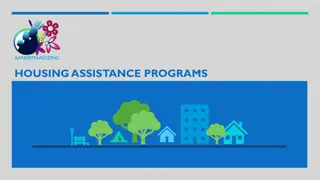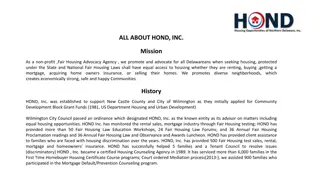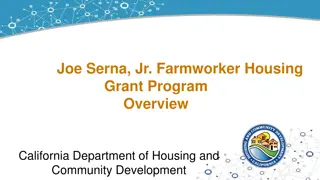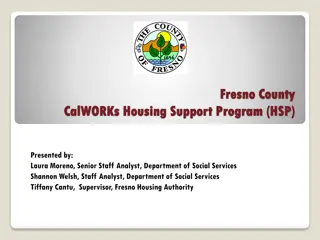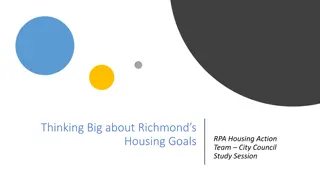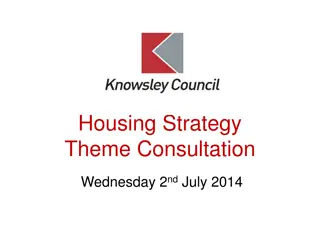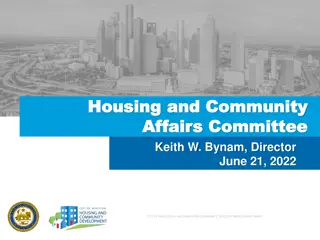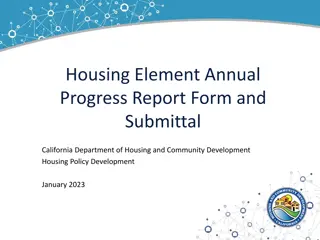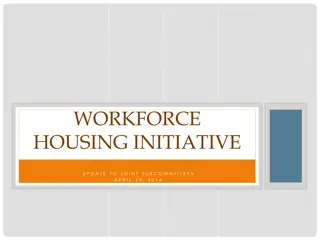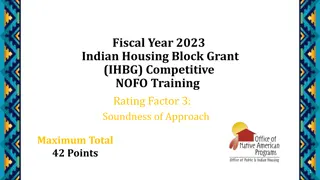Importance of Reporting for Housing and Community Development Programs
Learn about the significance of data reporting for Mayor's Office of Housing & Community Development programs. Discover the role reporting plays in decision-making, program improvement, advocacy, stakeholder communication, and advancing racial equity goals. Gain insights on how reporting can enhance partnerships, secure funding, and drive positive outcomes for marginalized communities.
Download Presentation

Please find below an Image/Link to download the presentation.
The content on the website is provided AS IS for your information and personal use only. It may not be sold, licensed, or shared on other websites without obtaining consent from the author.If you encounter any issues during the download, it is possible that the publisher has removed the file from their server.
You are allowed to download the files provided on this website for personal or commercial use, subject to the condition that they are used lawfully. All files are the property of their respective owners.
The content on the website is provided AS IS for your information and personal use only. It may not be sold, licensed, or shared on other websites without obtaining consent from the author.
E N D
Presentation Transcript
Mayors Office of Housing and Community Development Grantee Intake and Reporting Webinar July 19, 2021 [This webinar is being recorded] Mayor s Office of Housing & Community Development (MOHCD)
Agenda Webinar Logistics Data why it s important, how we use it, and how it can help you! Current Health and Safety Guidelines MOHCD Client Intake Form Guidelines and Instructions Q&A Part 1
Agenda (continued) Entering Clients into GMS Reporting Activities & Outcomes Uploads Client Reports Monthly Reporting and Invoicing Q&A Part 2
Webinar Logistics This webinar is being recorded, and will be posted on our website. Please type your questions into the Q&A panel. These will be answered during the two Q&A periods. During the Q&A period, you can also raise your hand if the typed question is not fully answered.
Ways in Which You Report to MOHCD Monthly program performance summaries (GMS) Monthly invoicing (GMS) Client demographic info and outcomes (GMS) Annual programmatic and fiscal/compliance monitoring Ad hoc requests
Why Reporting is Important Data-driven decision-making: Informs MOHCD s future investment strategies, procurements and funding decisions Continuous improvement: Helps build a data-driven partnership and feedback loop between your organization and our program officers Advocacy: Ensures that the agency is properly compensated and recognized for the work that you do, and that you and MOHCD are able to accurately tell your story Stakeholder reporting: MOHCD is required to report to HUD and other City agencies as a condition of funding
Why reporting is important for racial equity MOHCD seeks to advance opportunities and improve programmatic outcomes for Black, Brown, low-income residents, and other groups experiencing significant disparities We will use your client demographic data to assess how well programs and procurements are advancing the City s racial equity goals
Current Health & Safety Guidelines The Safe Return Together order issued by the Department of Public Health went into effect on June 15th. This order lifts several previous restrictions regarding capacity limits, social distancing, etc. Please review the order here: https://www.sfdph.org/dph/alerts/files/C19-07-Safer-Return-Together- Health-Order.pdf When appropriate, some services may still be provided remotely Please continue to follow official guidance regarding health and safety, available on the DPH website and through the CDC. MOHCD will share updates to guidance with grantees as they become available.
Client Intake Form All clients served starting July 1st must be recorded through a new Client Intake Form, and the information on this new form must be reflected on MOHCD s Grant Management System (GMS) Please review Client Intake Form Instructions, along with the form itself (available in English, Spanish, Chinese and Filipino). These documents are available at: https://sfmohcd.org/community-development-forms-and- documents
Client Intake Form (continued) A completed form must be collected for every client receiving a direct client service through an MOHCD project, regardless of fund source, or that client cannot be reported on GMS The only exceptions are Non-Client Activities for which doing an intake is not feasible (participants in large events and meetings, those receiving outreach materials or basic information, etc). These numbers are reported as headcounts on GMS without any individual information attached.
Using Alternate Form Your agency may use an alternate paper form or an electronic intake form if it: 1) contains allrequired elements from the Client Intake Form, including confirmation by staff and client that all information is accurate 2) can be printed out 3) has been approved by your Program Officer
Important changes in 2021-22 We will go through the Client Intake Form section by section, but will spend a bit more time reviewing these two important changes for 2021-22 Changes to Income Certification Requirements Client Intake Form new questions regarding Veteran and Disability Status
Client Intake Form, including Required Fields and Confidentiality Allowances for Specific Programs Information on the form, including client s full name, street address and date of birth, is required. The only optional fields are phone number, email address, gender pronoun and preferred name. For certain programs (those serving survivors of domestic violence, and some legal providers) alternate information may be provided. Client Name or ID - Acomplete client name is required. Contact your Program Officer to request the use of unique client identifiers if your agency provides domestic violence or legal services. Street Address A full street address is required. For some client populations with extreme confidentiality concerns (specifically immigration legal services and domestic violence providers) contact your program officer about using intersections (i.e., Market Street and 6th Street). This allows us to map the reach and impact of our services without using an individual s address.
Date of Birth - Client Intake Form A complete date of birth is required. For client populations with extreme confidentiality concerns (specifically immigration legal and domestic violence providers), a dummy day and month may be used, along with the actual year of birth (i.e., 01/01/1975). Contact your Program Officer to request the use of incomplete Date of Birth information. For other programs, if specific clients are not comfortable providing their date of birth, this method can also be used in order to obtain information regarding age without creating a barrier to service.
Race and Ethnicity - Overview MOHCD revised its race and ethnicity guidelines in 2020-21 to collect more detailed and accurate information. This improves our ability to evaluate how well our programs are meeting the needs of the many different communities that are part of our city, and how well we are addressing racial disparities and achieving racial equity goals. The race and ethnicity categories listed on the client intake form represent MOHCD s understanding of the race and ethnicity of our intended beneficiaries, the extremely low- income, low-income, and moderate-income residents of San Francisco.
Race/Ethnicity - Client Intake Form There are seven broad categories of race/ethnicity Each category has multiple choices within it The client will select from the more specific choices with check boxes, not the broad categories The client will select as many choices as they identify with If they select an Other choice, please ask them to specify and include their response onto the form. [Note: The additional information in the Please Specify lines is not required.]
Sexual Orientation and Gender Identity (SOGI) We collect this data in order to Learn more information about SF s LGBT population Learn how LGBT community members are impacted by issues such as poverty and COVID-19 Help ensure equity to city services between LGBT and non-LGBT constituents We also collect this in response to both City Ordinance and State Law
When Talking to Clients About SOGI Assure Confidentiality this is private information People are not obligated to answer Ask for self-identification (the client identifies themselves, they are not labelled or identified by staff) Respect name and pronouns that the individual uses Affirm that responses will not affect services provided Affirm that the agency is committed to providing a safe and respectful space Note: We are working with the Office of Transgender Initiatives on a recorded training for grantees specifically regarding SOGI reporting. This will be available on our website.
Sexual Orientation or Sexual Identity Client should choose the ONE option that best describes their sexual orientation or sexual identity? Bisexual Gay/Lesbian/Same-Gender Loving Questioning/Unsure Straight/Heterosexual Not Listed. Please Specify: _______ [Not Required] Decline to Answer
Gender Pronoun & Preferred Name [Optional] What gender pronouns do you use? [Optional] (Mark ONE) She/Her/Hers He/Him/His They/Them/Theirs Not Listed. Please Specify: _____________ By what name do you wish to be called? [Optional]
Primary Language What is your primary language spoken at home? (Mark ONE) Chinese Cantonese Chinese Mandarin English Filipino Russian Spanish Vietnamese Other Language. Please Specify: ___________________
NEW - Veteran Status Definition: Veterans are men and women who have served (even for a short time), but are not currently serving, on active duty in the U.S. Army, Navy, Air Force, Marine Corps, or the Coast Guard, or who served in the U.S. Merchant Marine during World War II. People who served in the National Guard or Reserves are classified as veterans only if they were ever called or ordered to active duty, not counting the 4-6 months for initial training or yearly summer camps. All other civilians are classified as nonveterans. This is a Yes/No question on the form. On GMS it is a checkbox that is only used if the client answered Yes.
NEW - Disability Status A person with any one of the following six disability types is considered to have a disability: Hearing difficulty: deaf or having serious difficulty hearing Vision difficulty: blind or having serious difficulty seeing, even when wearing glasses Cognitive difficulty: Because of a physical, mental, or emotional problem, having difficulty remembering, concentrating, or making decisions Ambulatory difficulty: Having serious difficulty walking or climbing stairs Self-care difficulty: Having difficulty bathing or dressing Independent living difficulty: Because of a physical, mental, or emotional problem, having difficulty doing errands alone such as visiting a doctor s office or shopping This is a Yes/No question on the form. On GMS it is a checkbox that is only used if the client answered Yes.
Family Size and Income Family is a self-defined unit. It includes, but is not limited to, the following regardless of actual or perceived sexual orientation, gender identity, or marital status: a single person or a group of persons residing together. Clients should indicate if they are a Single Headed Family or Dual Headed Family (one or two adults functioning as head of the family or household). Estimated income for the next twelve months this is the federal standard this includes all adult members of the family, and all sources of income (including benefits) Note - The chart showing what income category the family is in has been taken off the form and moved to the instructions. This is automatically calculated on GMS. Reminder that the majority of clients served through your projects must be extremely-low, low and moderate income.
IMPORTANT: Income Certification Grantees much make their best efforts to verify the income of clients by requesting that clients provide income certification documents CDBG-funded projects must collect and retain copies of income certification documents. CDBG funded projects must be able to clearly document that a majority of clients are income certified low or moderate income individuals. General Fund and other non-CDBG funded projects must review income certification documents, but do not to collect and retain these documents. In this case, the staff signature serves as confirmation that income was certified.
Income Certification (continued) If certification documents are not provided, please mark Self-Certified on the Client Intake Form and provide an explanation If the client is unable to provide documentation in an initial intake, please request that they provide that at their next point of service. Grantees must protect the Personally Identifiable Information (PII) of clients. Clients should never be asked to send documents containing PII through regular, unsecured or unencrypted, email
Income Certification Process Public Benefits: First ask if the client receives any public benefits, and mark all that apply. This is also an opportunity to explore if there are other forms of public benefits that this client may be eligible for. Source(s) of income used to verify: If the client provides income certification documents, mark those documents provided. If they provided documentation of any of the public benefits listed, check the Public Benefits box If the client does not provide income certification documents, use the Self-Certified box, and provide an explanation For example, Client on CalFresh but did not have income documents.
Signatures Signatures of client and interviewing agency staff are required. If the service is provided remotely, and for those projects granted permission to use unique identifiers, only staff signature is required. For CDBG-funded projects, all youth under 18 must have a parent/guardian complete and sign the form.
Q&A Part 1 We ll now take a break to answer questions on the first part of the presentation
Entering Clients into GMS 2021-22 clients can be entered in GMS now First, you must select an MOHCD project (from 2020-21 or 2021- 22). You can no longer enter clients directly from your agency account, because there are different client forms for MOHCD and OEWD projects. Select Clients from the left side bar, then Add People from the set of top tabs, to access the client entry screen The steps to enter a client on GMS are covered on pages 53-55 of the GMS User Guide, which includes screen shots of each step Note: You can use the auto-generated Upload ID or select your own it is best if this Upload ID does NOT start with a zero
Viewing and Editing Clients on GMS In the Clients tab, select View People If the client does not have a completed form on GMS, the record will be marked Incomplete and you will not be able to link them to Activities and Outcomes To edit or update a client, click on their name and you will be taken to their client record
Activities and Outcomes Once a client has been entered and saved, and the 2021-22 contracting process has been completed for that project, clients can be linked to Activities and Outcomes The steps for linking clients to Activities and Outcomes are covered on pages 71-73 of the GMS User Guide, which includes screen shots of each step
Uploading Data on GMS Grantees have the ability to mass upload both Client and Activity & Outcome information onto GMS using an Excel spreadsheet and the GMS Upload tool For training on how to perform uploads, please watch the video and download the Powerpoint from our December 17, 2020 training at: https://sfmohcd.org/grantees-training Client uploads are available now, Activity & Outcome uploads will be available once contracting is completed
Client Uploads Please also review the section in the GMS User Guide regarding client uploads (pages 62-68) The updated client upload template is now available on GMS In order to upload clients for 2020-21 or 2021-22, you must use the updated template that includes columns for Veteran and Disabled. You only need to enter a value if the client answered Yes to one of these questions, so GMS will accept blank fields in the upload spreadsheet for these two columns.
Activity and Outcome Uploads Please also review the section in the GMS User Guide regarding activity and outcome uploads (pages 76-79) There is one separate upload process for activities, and another for outcomes Each is a multi-step process, and will take some time to set up properly
Client Reports Available on GMS The following client reports are available to grantees under the Client Reports tab the left side menu on GMS Unduplicated Clients by Agency Client Activities and Outcomes Includes individual client information for each client linked to each activity and outcome Activities and Outcomes Summary Shows overall goals and reported numbers for each activity and outcome
Monthly Reporting Available Once Contracting is Completed Executive Summary Two required narrative responses each month, two optional. Please provide detailed narratives. Activities and Outcomes Client Activities and Outcomes automatically roll up from reporting Non-Client Activities are reported directly into this form Invoice Approval [by Signatory]
Monthly Reporting (continued) Once the contracting process is complete, Monthly Reports should be submitted by the 15th of the following month So, if we are able to complete the negotiation and contracting process in time, agencies would submit their July 2021 reports by August 15th If your agency needs to work on a modified schedule (for fiscal reasons, etc.), get pre-approval from your Program Officer
Looking forward You should be collecting updated Client Intake Forms, and can enter client information on GMS now You will not be able to enroll clients in Activities or Outcomes, or access monthly reporting, until the contracting process is completed for that project So, our priority remains to complete the grant negotiation and contracting process as quickly as is possible
And in conclusion That was a lot of information, we are here to help Please review the relevant sections of the GMS User Guide, and recommended trainings on our website A recording of this webinar and a copy of this PowerPoint will also be available at: https://sfmohcd.org/grantees-training The staff of MOHCD looks forward to working in partnership with you!


